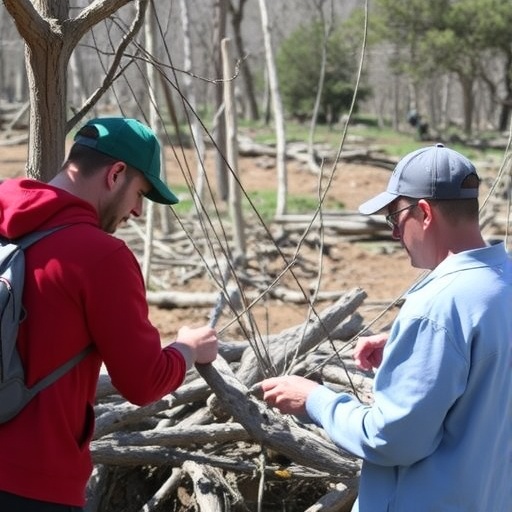In a significant advancement in forest ecology, a recent study by Ghahramany, Azari, and Valipour presents a comprehensive assessment of post-fire sprouting in the oak species of the Zagros forests in Western Iran. As wildfires escalate globally due to climate change and human activities, understanding the regeneration processes of vital tree species becomes paramount. The research published in Environmental Monitoring and Assessment delves into the enduring resilience of oak species following fire disturbances, shedding light on their ecological significance and survival strategies.
The Zagros mountains, a key ecological zone rich in biodiversity, face frequent and increasingly severe wildfires. These fires not only devastate forest ecosystems but also threaten the myriad of life forms that depend on these habitats. Oaks, particularly, are critical in these ecosystems as they provide food and shelter for various wildlife. However, the ability of these trees to recover post-fire is under scrutiny, making this research particularly timely and relevant.
The methodology employed in this study involved a meticulous selection of sites within the Zagros forests that had recently been affected by wildfires. Researchers meticulously documented the conditions of oak species, measuring parameters such as the number of sprouts, their height, and the overall health of the trees post-fire. This quantitative assessment was aimed at establishing a clear understanding of how these oak species respond to the stresses imposed by fire.
Interestingly, the results indicated that certain oak species demonstrated remarkable resilience post-fire, engaging in vigorous sprouting. This sprouting behavior is not merely a survival mechanism but also serves an essential role in maintaining the ecological balance within the forest. The ability to rapidly regenerate helps stabilize the soil, prevent erosion, and support the recovery of other plant species in the area, fostering a healthy ecosystem.
Another pivotal aspect of the study was the analysis of factors influencing sprouting success among different species of oak. Researchers found that variables such as soil type, moisture availability, and fire intensity significantly influenced the regeneration patterns observed. These findings provide critical insights into how environmental conditions play a role in determining the resilience of forest species post-disturbance.
Moreover, the study underscores the importance of genetic diversity among oak species. Diverse genetic traits can enhance a species’ adaptability to changing environmental conditions, making it crucial to preserve these variations. This aspect not only impacts the survival of oaks but also has broader implications for forest management and conservation strategies.
The researchers also highlighted the implications of climate change on future fire events and, consequently, the regenerative capacity of oak forests. With rising temperatures and shifting precipitation patterns, the invasiveness of fires is expected to increase, posing a significant threat to forest ecosystems worldwide. Understanding how oak species respond to these changes will be essential for developing strategies aimed at conservation and preservation.
Forest managers, conservationists, and policymakers can glean valuable lessons from this study. The findings emphasize the need for proactive measures, such as controlled burns and selective logging, to enhance the resilience of oak forests against the inevitable increase in fire frequency and intensity. By managing these forests more intelligently, we can support the natural regenerative processes of oak species.
The research also raises critical questions about the long-term sustainability of oak forests in the face of compounded environmental stressors, such as pest infestations and diseases exacerbated by climate-induced changes. Continued monitoring and assessment efforts will be essential to adapt management practices and policies in a rapidly changing climate.
In addition to ecological insights, the study prompts wider discussions on the interconnectedness of forest ecosystems and human well-being. Healthy oak forests contribute to air and water quality, carbon sequestration, and biodiversity conservation, all critical for a sustainable future. Hence, protecting these forests and understanding their dynamics post-fire is not just an ecological concern but a societal imperative.
As the study paves the way for future research, it calls for an interdisciplinary approach that incorporates ecological, social, and economic perspectives in managing forest resources. Collaborative efforts among scientists, policymakers, and local communities will be essential to foster resilient landscapes that can withstand the pressures of climate change.
The essence of this research lies in its contribution to our understanding of fire dynamics in forest ecosystems and the adaptive capacities of tree species. By recognizing the inherent resilience of oak species, we can glean hope for the future of forest ecosystems. The survival and restoration of these forests hinge on our ability to learn, adapt, and implement effective conservation strategies informed by scientific research.
In conclusion, this research serves as a call-to-action for all stakeholders involved in forest management and conservation. The resilience of oak species in the Zagros forests is not an isolated phenomenon but rather a reflection of the interconnectedness of ecological health and biodiversity conservation. As we navigate the complexities of climate change, studies like this illuminate pathways toward sustainable management of our natural resources, ensuring that forests continue to thrive for generations to come.
Subject of Research: Post-fire sprouting in oak species of the Zagros forests.
Article Title: Assessment of post-fire sprouting in oak species of the Zagros forests, Western Iran.
Article References:
Ghahramany, L., Azari, S. & Valipour, A. Assessment of post-fire sprouting in oak species of the Zagros forests, Western Iran.
Environ Monit Assess 197, 1185 (2025). https://doi.org/10.1007/s10661-025-14657-4
Image Credits: AI Generated
DOI:
Keywords: Oak species, Zagros forests, post-fire sprouting, resilience, climate change, wildfire recovery, forest management, biodiversity conservation, ecological health.




